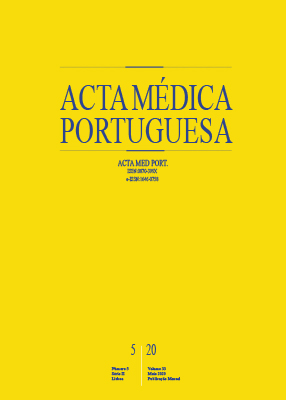Frequent Users of the Pediatric Emergency Department: To Know, To Intervene and To Evaluate - A Pilot Study
DOI:
https://doi.org/10.20344/amp.12769Keywords:
Emergency Service, Hospital, Health Services Misuse, Pediatrics, PortugalAbstract
Introduction: Frequent users contribute to an excessive volume of admissions in the emergency department, impairing the quality of healthcare services. The aim of this study was to identify and characterize the population of frequent users of the pediatric emergency
department, establish an individual plan of intervention and evaluate its efficacy.
Material and Methods: Intervention study including children and adolescents younger than 16 years, with more than 10 visits in a year to an emergency department of a secondary care hospital. An intervention program was created with a multidisciplinary team and a case manager, who was responsible for the execution of the individual plan of intervention. One year later, the number of visits after the intervention was assessed.
Results: We identified 90 patients with a frequent user profile, with 1182 visits. Only 17.3% of the visits had a previous referral. Most of the visits were considered non urgent/less urgent (59%). The intervention included 82 children/adolescents. One year later, there was a significant reduction in the number of visits: median reduction of 62% in 78 participants.
Discussion: Most of the visits by frequent users were considered non urgent/less urgent, reflecting a clinically unjustified use of the emergency department. The intervention seems to be effective as the number of visits decreased.
Conclusion: This population of frequent users seems to be a heterogeneous group with different problems and levels of complexity. A multidisciplinary and individual intervention, with a case manager, might contribute to reduce the excessive use of the emergency department and improve the provision of health care services to these children.
Downloads
Downloads
Published
How to Cite
Issue
Section
License
All the articles published in the AMP are open access and comply with the requirements of funding agencies or academic institutions. The AMP is governed by the terms of the Creative Commons ‘Attribution – Non-Commercial Use - (CC-BY-NC)’ license, regarding the use by third parties.
It is the author’s responsibility to obtain approval for the reproduction of figures, tables, etc. from other publications.
Upon acceptance of an article for publication, the authors will be asked to complete the ICMJE “Copyright Liability and Copyright Sharing Statement “(http://www.actamedicaportuguesa.com/info/AMP-NormasPublicacao.pdf) and the “Declaration of Potential Conflicts of Interest” (http:// www.icmje.org/conflicts-of-interest). An e-mail will be sent to the corresponding author to acknowledge receipt of the manuscript.
After publication, the authors are authorised to make their articles available in repositories of their institutions of origin, as long as they always mention where they were published and according to the Creative Commons license.









